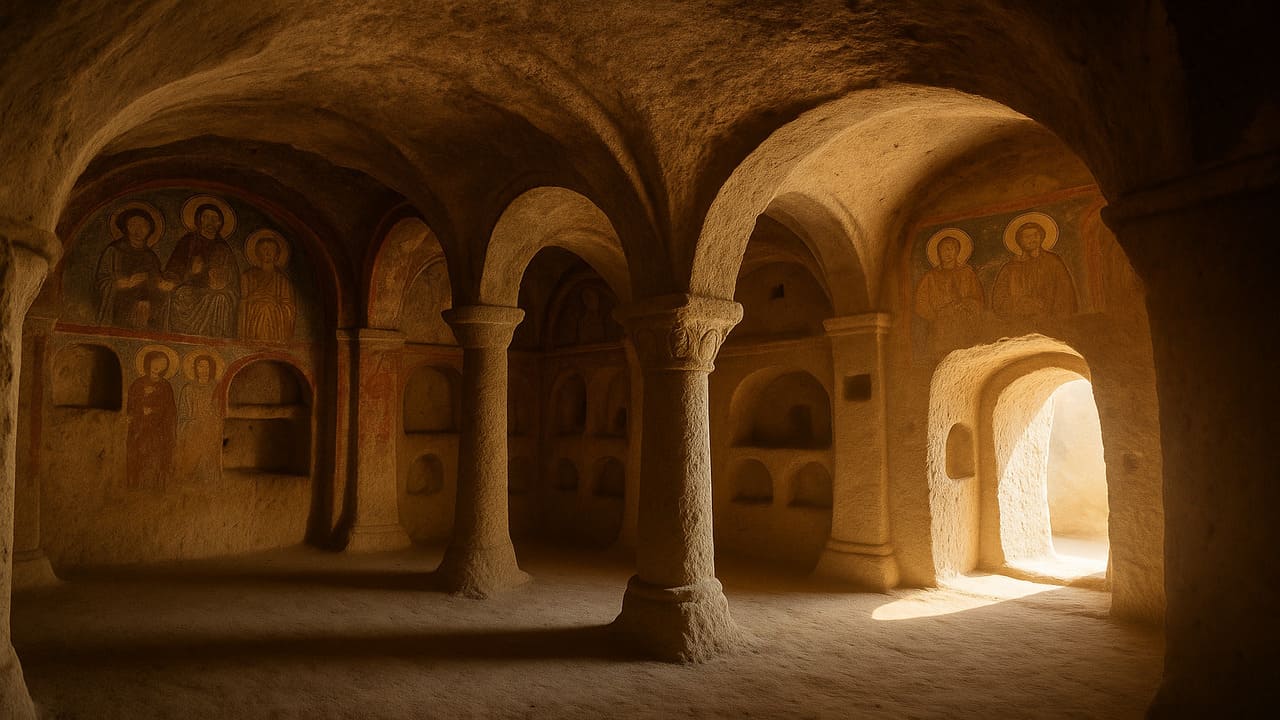
Thorn Ville Church – Beneath the surreal volcanic landscapes of central Turkey lies a network of rock-hewn sanctuaries known as the Cappadocia Cave Churches. These ancient spaces were more than architectural wonders they were places of refuge, resistance, and remarkable faith. Hidden from the world, carved into soft tuff rock, these cave churches tell a story of early Christianity’s survival during times of persecution.
Today, they stand as silent testaments to spiritual resilience. Drawing visitors from around the globe who seek to understand the faith, art, and courage that once lived within these underground chapels.
Cappadocia’s landscape, shaped by millennia of volcanic activity, is a breathtaking mix of fairy chimneys, valleys, and soft stone formations. But while tourists may first be captivated by the region’s geography. It is Cappadocia’s hidden interiors its caves, tunnels, and hollowed sanctuaries that hold the most fascinating stories.
Beginning in the 4th century AD, early Christians fleeing Roman persecution took to these volcanic hills for shelter. They carved homes, monasteries, and places of worship directly into the cliffs. These underground sanctuaries offered both safety and silence, allowing communities to worship away from the eyes of oppressive authorities.
Also Read : British Lawmakers Target Exploitation: Bill Aims to Criminalize Pimping Platforms
Cave churches in Cappadocia were not crude shelters; they were carefully designed places of worship. Many feature vaulted ceilings, apses, altars, and narthexes, just like above-ground churches. Some include frescoes painted in vibrant reds, blues, and golds, depicting Christ, Mary, apostles, saints, and biblical scenes though often simplified to avoid Roman detection.
The Göreme Open-Air Museum, now a UNESCO World Heritage Site, preserves some of the finest examples. The Dark Church (Karanlık Kilise) is particularly notable for its well-preserved frescoes that illustrate the life of Christ. Nearby, Tokalı Church features a deep blue arched ceiling with elaborate iconography. While Elmali Church (Apple Church) shows vivid scenes of the Last Supper and Crucifixion.
For early believers, entering these stone-carved halls meant stepping into sacred space, a place where faith was kept alive through whisper and worship, not grandeur or wealth.
Cappadocia’s religious structures were part of a much larger system of survival. Beneath the valleys are sprawling underground cities, such as Derinkuyu and Kaymakli, capable of housing thousands of people. These cities connected through narrow tunnels and included ventilation shafts, wells, kitchens, and even wine presses.
Churches were a vital part of these complexes. Often hidden behind secret doors or passageways, they provided spaces for communal prayer, baptisms, and liturgies. In many cases, cross-shaped engravings can still be find etch onto the walls, offering clues to the ancient rituals practiced in secret.
These were not temporary hideouts they were long-term refuges, active for centuries as waves of persecution, war, and political instability swept across the region.
Also Read : Timeless Sanctuaries: Exploring the Most Iconic Ancient Churches of the World
In recent decades, Cappadocia has become a popular travel destination, with its hot air balloons and cinematic views attracting millions. But beneath the tourism lies a deeper story one of a persecuted faith, communal strength, and architectural ingenuity.
Efforts to preserve and restore the cave churches have been ongoing. Organizations and historians continue to document the delicate frescoes. Many of which have suffered from erosion, vandalism, or smoke damage over time. Today, visitors are encourage to enter respectfully, understanding that these aren’t just tourist sites they are living relics of spiritual history.
The legacy of the Cappadocia Cave Churches continues to inspire. For modern Christians and history enthusiasts alike. Walking through these stone corridors is like stepping into a sacred timeline where prayer echoed off cool stone, and belief endured despite fear.
Thornville Church - Your Source for Biblical Inspiration - Sacred art in churches became a visual language that shaped early…
Thornville Church - Your Source for Biblical Inspiration - Across changing empires and cultures, historic churches preserved Christian teachings with…
Thornville Church - Your Source for Biblical Inspiration - The miracle of spiritual deliverance appeared in Philippi when Paul freed…
Thornville Church - Your Source for Biblical Inspiration - Historians now highlight how women in early church shaped theology, leadership,…
Thornville Church - Your Source for Biblical Inspiration highlights how church orientation toward east shapes Christian worship, architectural symbolism, and…
Thornville Church - Your Source for Biblical Inspiration reports that recent necropolis discoveries at Colossae are reshaping how scholars read…